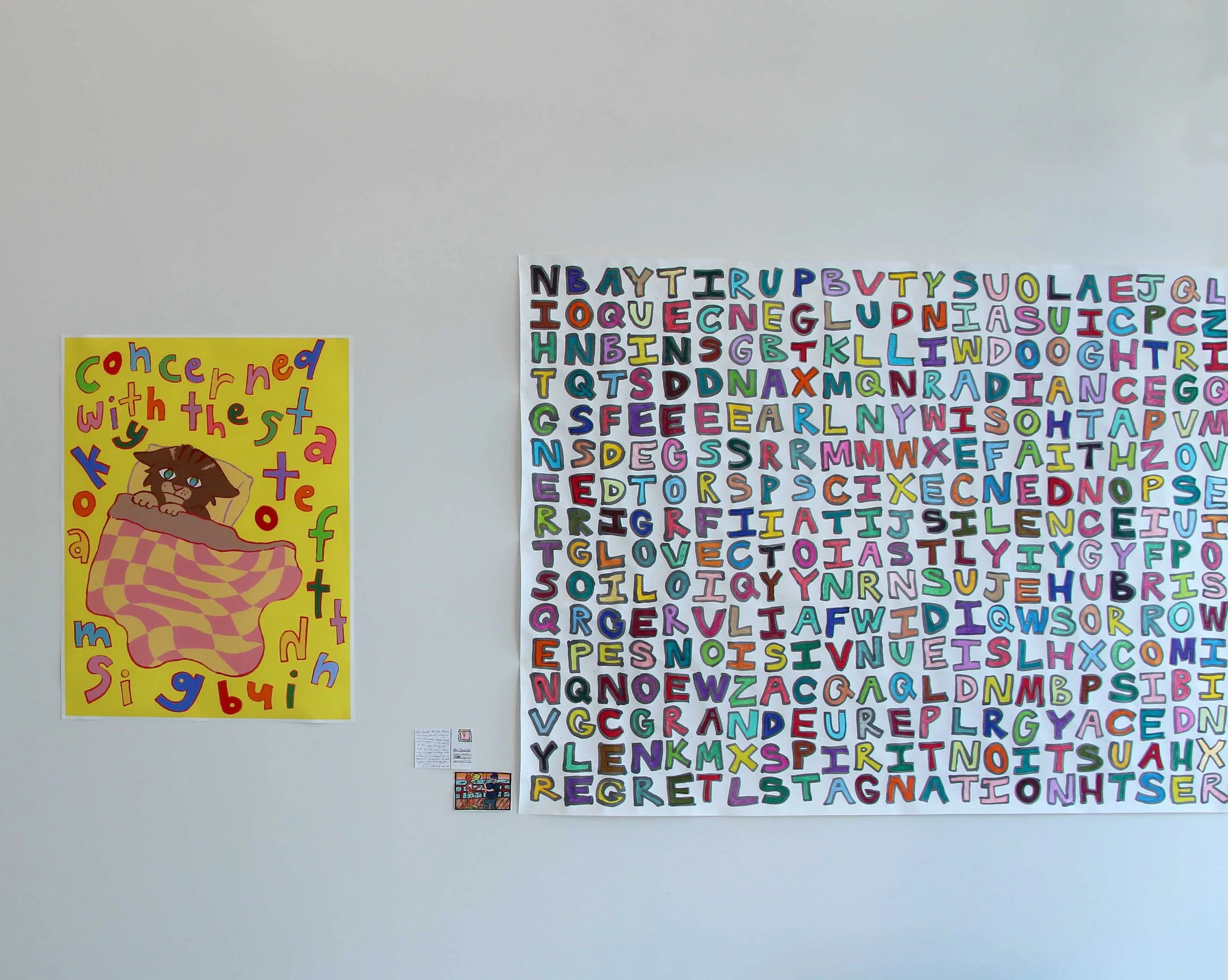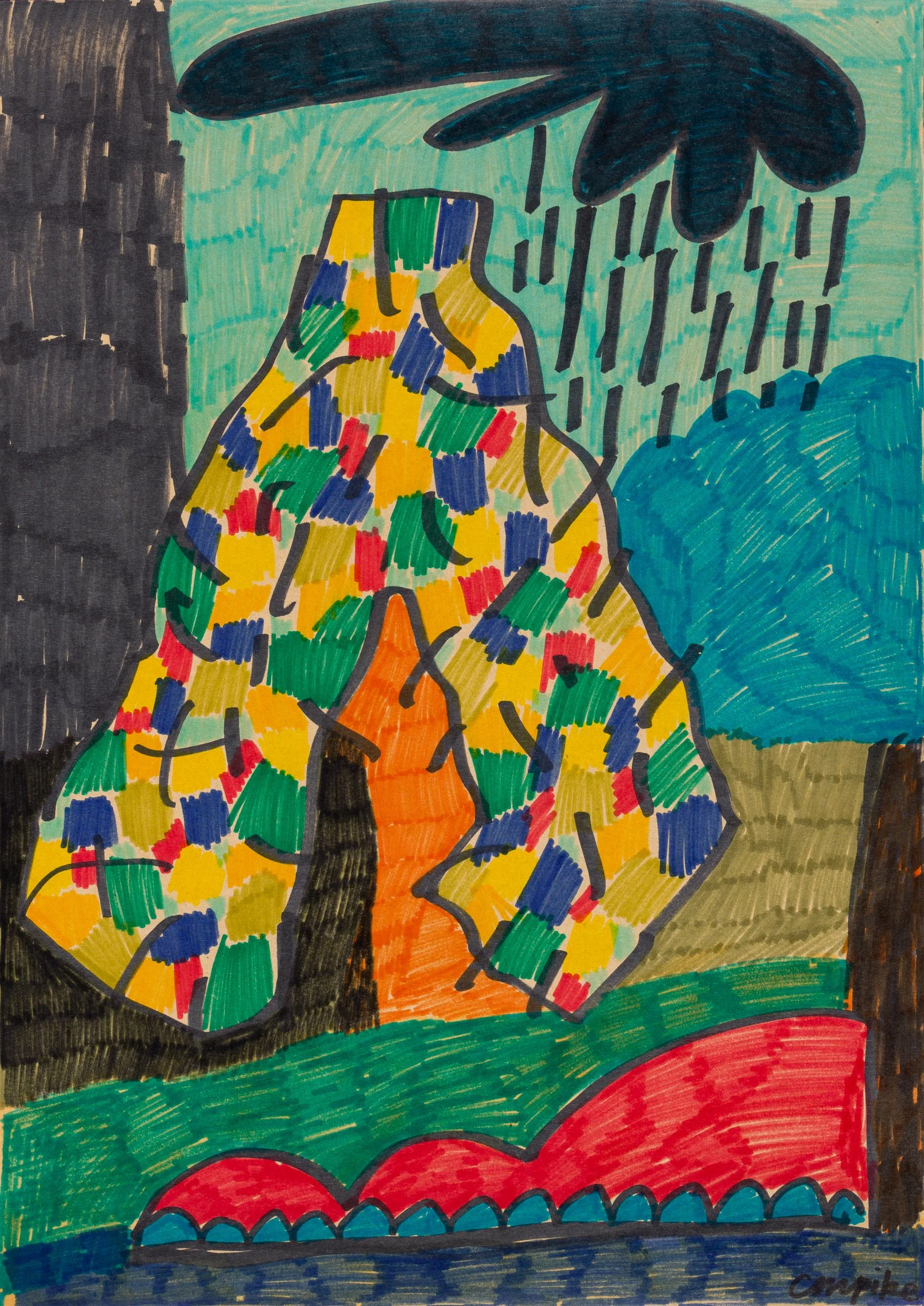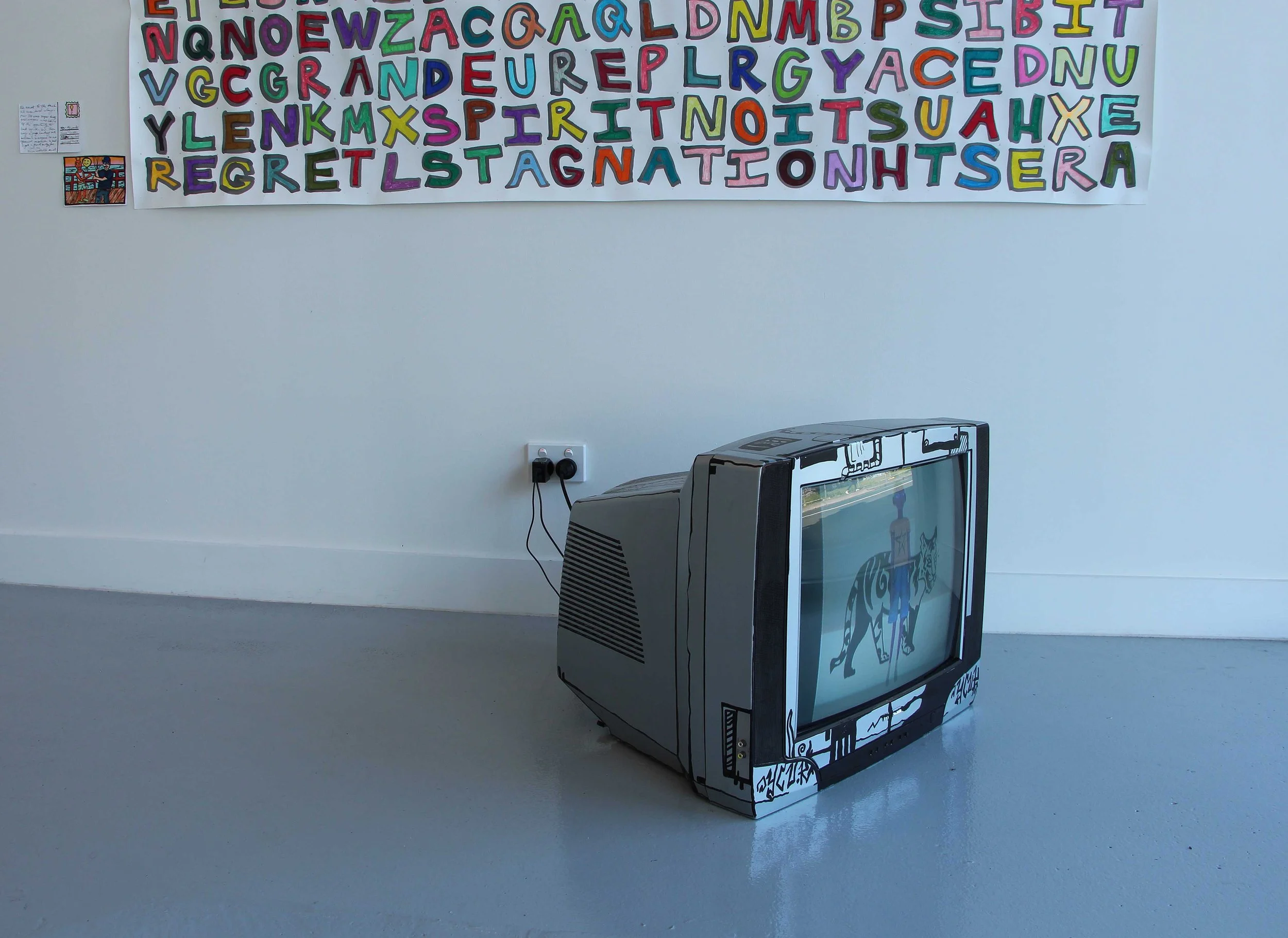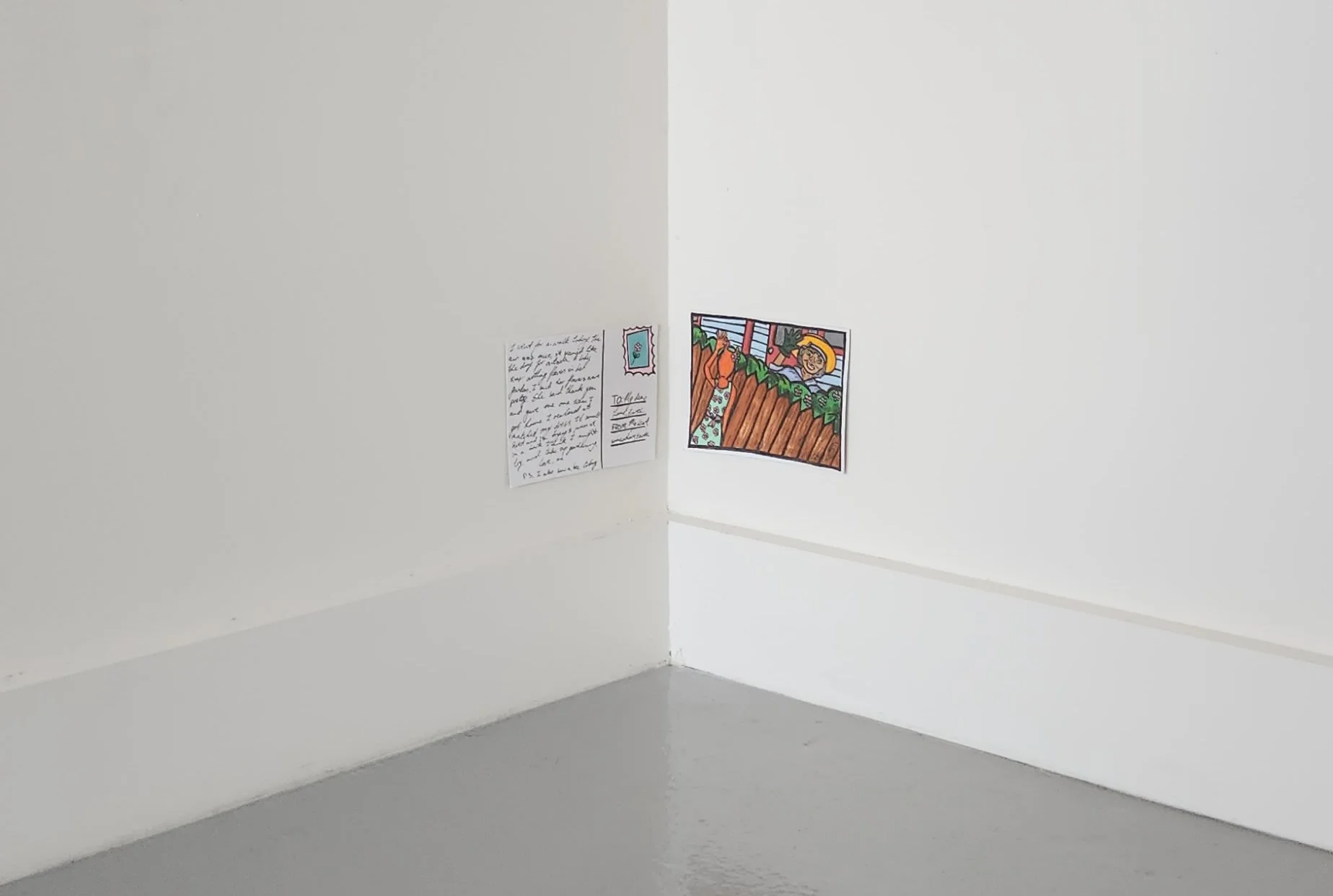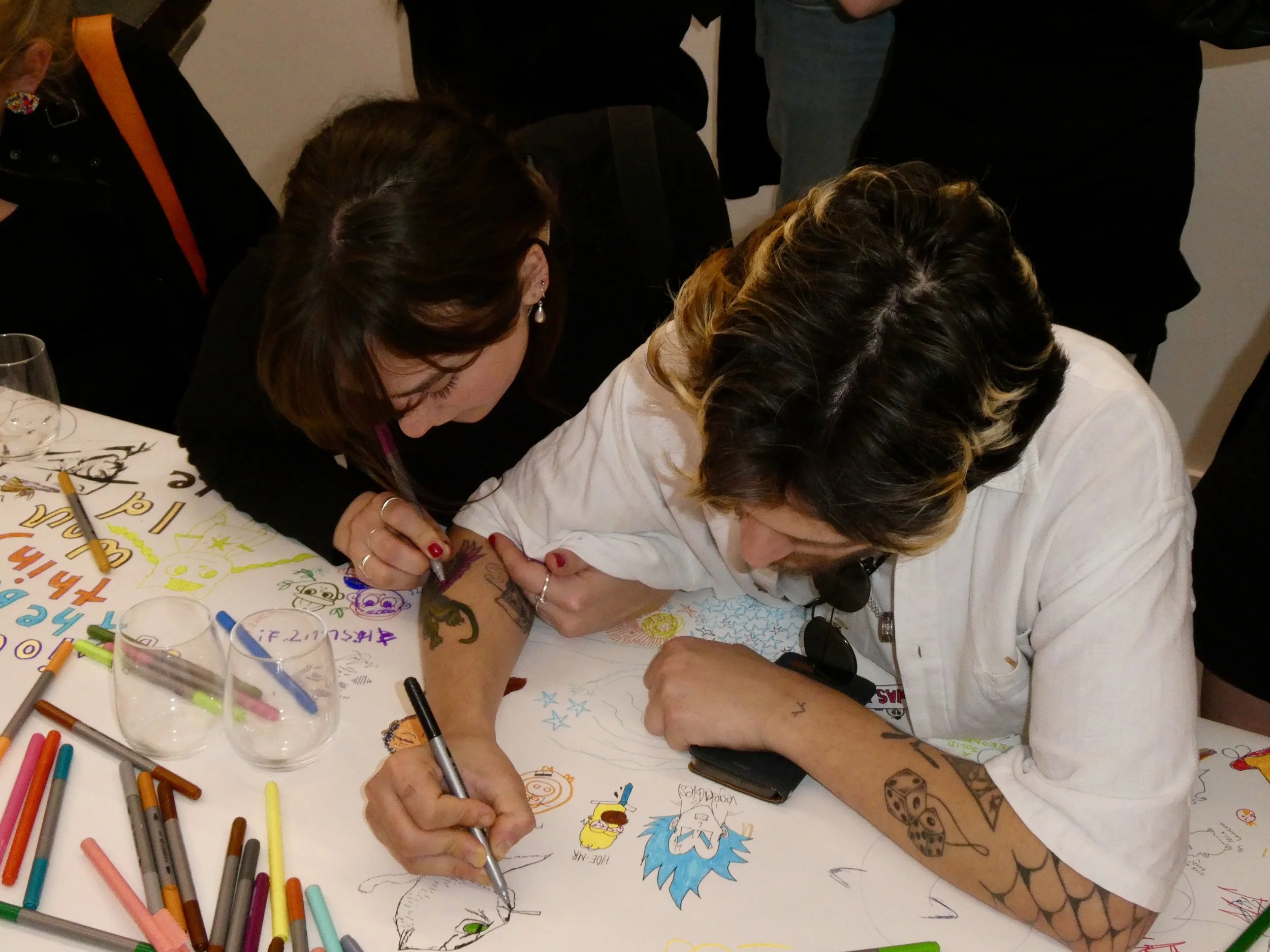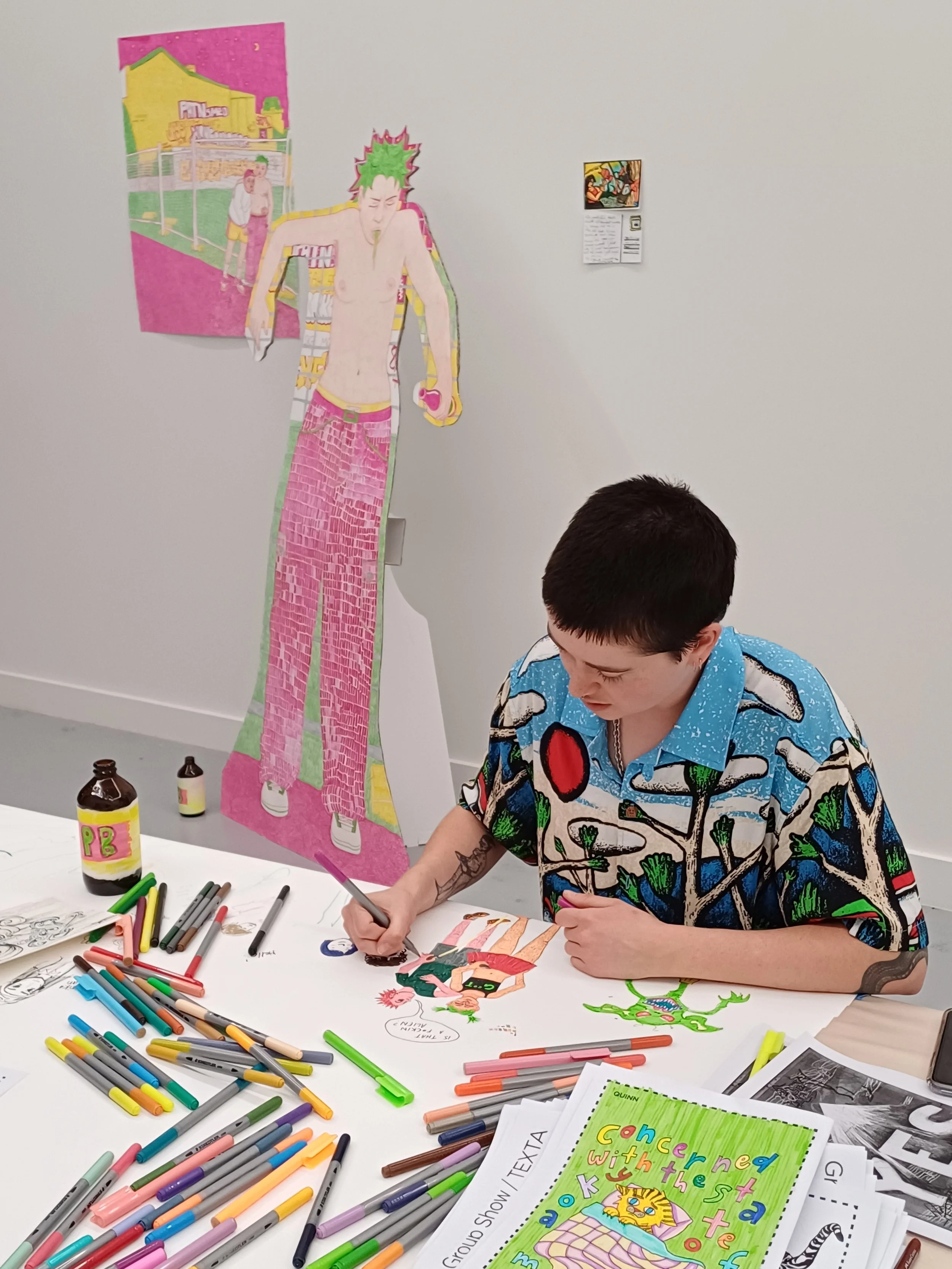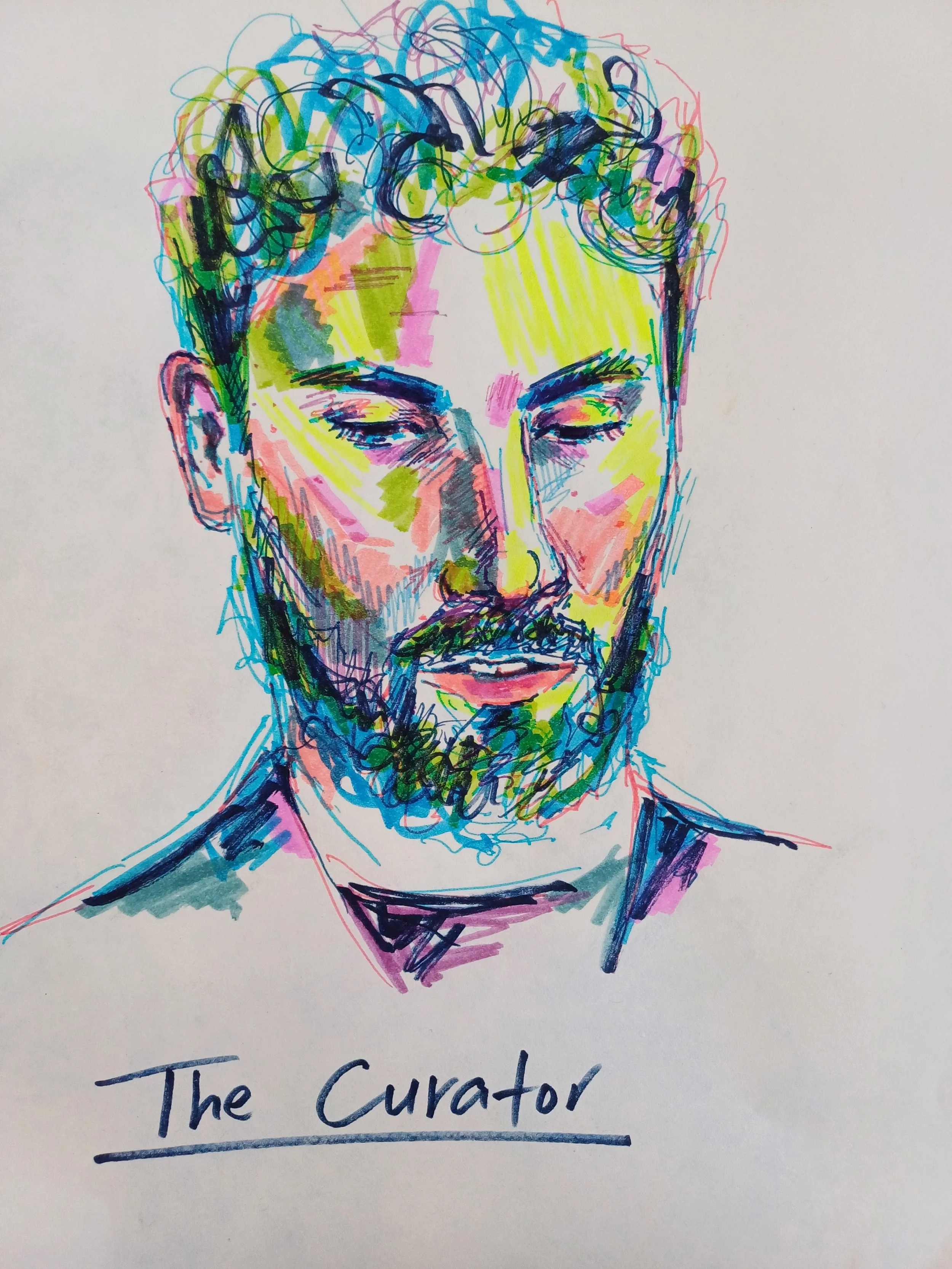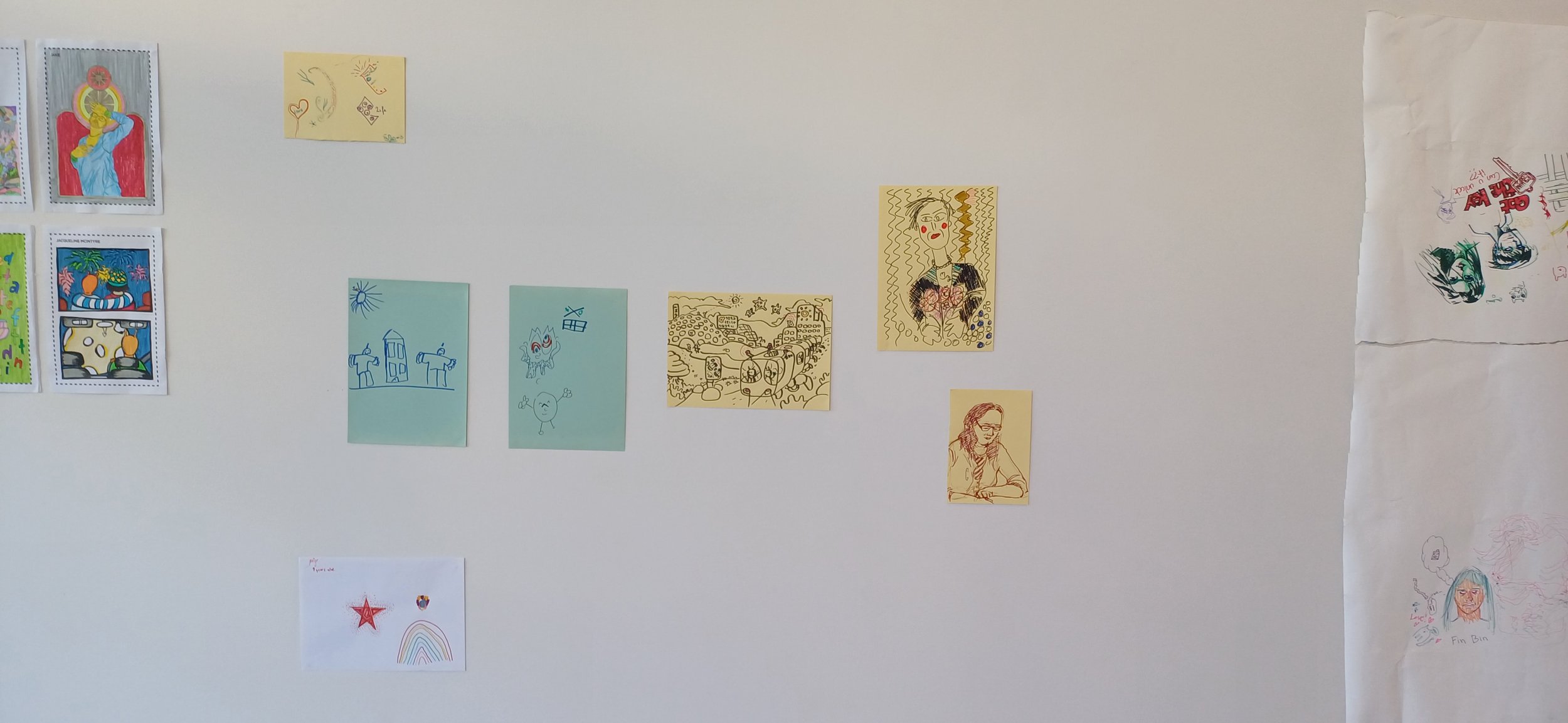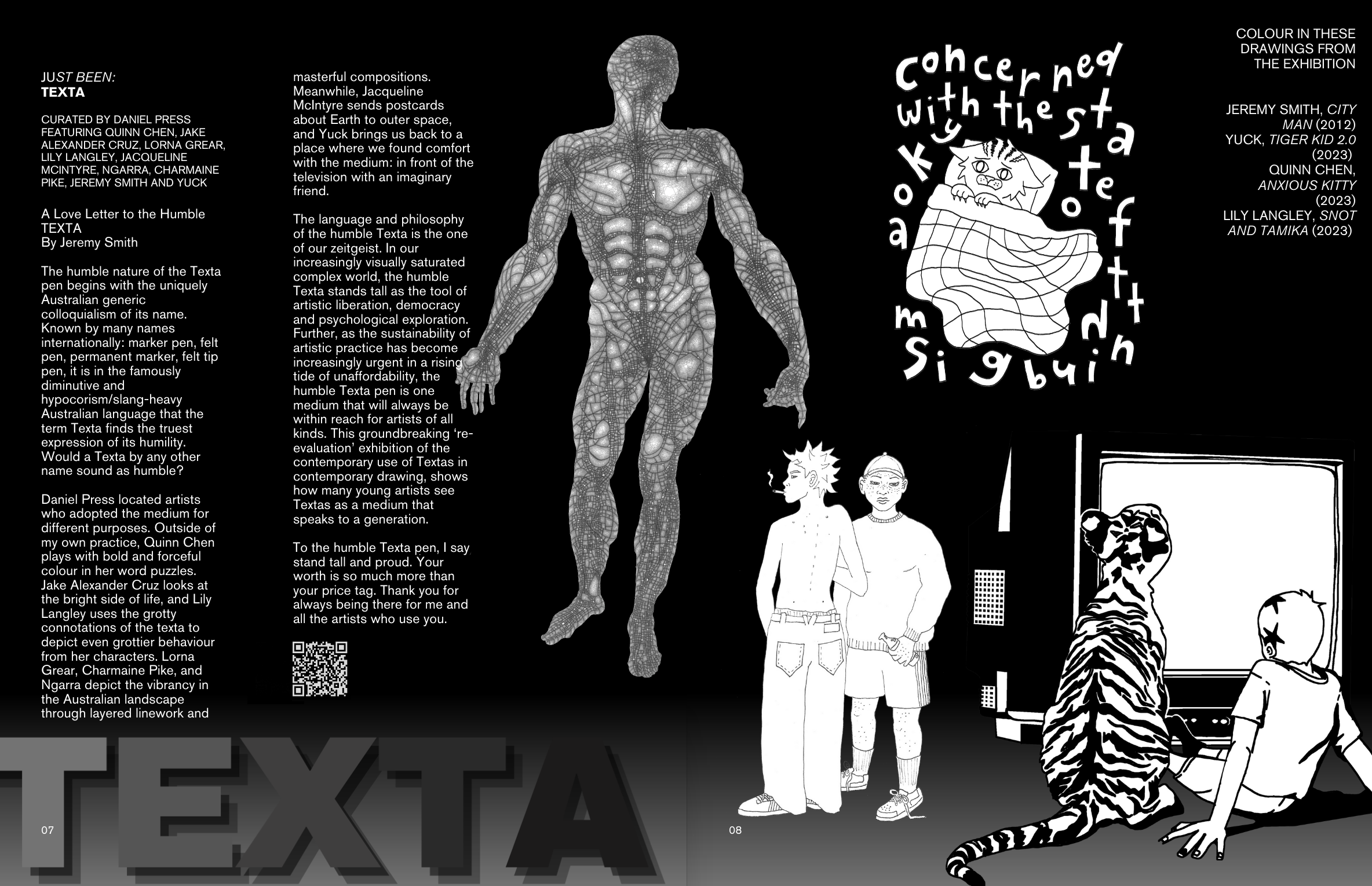Group Show / TEXTA
October 5, 2023 - November 5, 2023
DRAW Space
Textas, or felt pens, are an ubiquitous medium that many grew up with. These pens encourage a drive to create and a sense of play. Often overlooked as a fine art medium, this exhibition shows how these humble pens can produce bold, forceful artworks that call for attention.
Artists: Quinn Chen, Jake Alexander Cruz, Lorna Grear, Lily Langley, Jacqueline McIntyre, Ngarra, Charmaine Pike, Jeremy Smith, and Yuck
Lorna Grear is represented by Flinders Street Gallery.
Charmaine Pike is represented by Defiance Gallery.
Ngarra is represented by Mossenson Galleries. Ngarra drawings courtesy of Mossenson Galleries and Mossenson Art Foundation.
Jeremy Smith is represented by .M Contemporary.
“This groundbreaking survey exhibition on the use of Textas in contemporary drawing shows how many young artists see Textas as a medium that speaks to a generation”.
— Jeremy Smith
Lily Langley, 'I miss the old petrol station' (left) and 'It's tactical...' (right) install shot, 2023. Texta on paper and cardboard stand. Image courtesy of the artist.
Lorna Grear, install shot, 2022-2023. Texta on paper. Image courtesy of the artist and Flinders Street Gallery.
Ngarra, 'Wominbah Boss Agula' detail, 1997-1998. Texta on paper. Ngarra drawings courtesy of Mossenson Galleries and Mossenson Art Foundation.
Jeremy Smith, 'SAINT SEBASTIAN', 2012. Pen ink on paper. Image courtesy of the artist and .M Contemporary.
Quinn Chen, 'Anxious Kitty' (left) and 'Scramble' (right) install shot, 2023. Gouache painting as an archival print, and ink and texta on paper. Image courtesy of the artist.
Charmaine Pike, 'Illuminance' XXIX, 2021. Texta on paper. Image courtesy of the artist and Defiance Gallery.
Jake Alexander Cruz, install shot, 2023. Markers on paper. Image courtesy of the artist.
Yuck, 'Tiger Kid 2.0', 2023. Animation on old television. Image courtesy of the artist.
Jacqueline McIntyre, 'Flower Garden Postcard' install shot, 2023. Texta on card. Image courtesy of the artist.
TEXTA / Lily Langley in conversation with Daniel Press
Lily Langley (AKA Motormouth Comics) utilises visual storytelling and character creation to envisage alternate realities, appropriating the masculine laconic figure of the larrikin to tell narratives of generational trauma, substance abuse, mateship and camaraderie. Lily's use of textas reference the childhood connotations of the medium and the hyper colour of comics and graffitied scrawls. For Lily, there's something both grotty and pure about a texta.
TEXTA / Jake Alexander Cruz in conversation with Daniel Press
Jake Alexander Cruz is known for his colourful self-portraiture. His lived experiences are performatively depicted with cel-shaded texta linework to challenge masculine roles and find love for his body. His work for TEXTA reflects on his religious schooling and depicts new developments with paper craft. Jake turns the regimented experiences of the church into something more joyous and playful, alluding to church architecture and stained glass windows.
TEXTA / Jeremy Smith in conversation with Daniel Press
Jeremy Smith is an artist and PhD Candidate at UNSW Art & Design. He is a co-founder of the Newtown-based ARI, DRAW Space, and the Curator and Curatorial Co-ordinator at Qtopia. Smith works in drawing and etching to subvert conventions of cartography, creating subjective psycho-geographic maps of psychological and imagined spaces such as identity, the subconscious and sexuality. He maps the LGBTQI community and the changing gay male body post the introduction of PrEP (the anti-retroviral HIV drug).
A love letter to the humble Texta
catalogue essay by Jeremy Smith
The humble nature of the Texta pen begins with the uniquely Australian generic colloquialism of its name. Known by many names internationally: marker pen, felt pen, permanent marker, felt tip pen, it is in the famously diminutive and hypocorism/slang-heavy Australian language that the term Texta finds the truest expression of its humility. Would a Texta by any other name sound as humble?
Historically, not all mediums were created equal. In the grand archaic hierarchy of artistic mediums, the humble Texta has long been relegated to the use of children, ‘outsider art’, graffiti, illustration or craft. If we consider this antiquated hierarchy of mediums with the long-venerated oil paint at the top, followed by marble or bronze sculptures, drawing (the practice within Textas often finds its application) would historically rank below other mediums. Drawing itself has often been characterised as secondary, a training tool, or preparatory work to those higher ranked mediums. Within the practice of drawing exists a further hierarchy of graphite pencils, charcoal and ink pens at the top, with pastels, crayons, chalk and the humble Texta at the bottom.
Yet the very characteristics why drawing (and, by extension, Texta) has often been looked down upon as a medium are today the reasons why they are experiencing a flourishing Renaissance of use, particularly among younger artists. These characteristics include directness, affordability, experimentation, vibrant ‘artificial’ colours, visibility of marks, simplicity, creative expression, quick-drying, portability, ease of use, rawness, modesty, blendablity and open-endedness, to name a few. As contemporary art has moved away from strict realism both in figuration and colour, these characteristics of drawing and Texta have become liberating, democratic mediums on the path to greater creative expression. These characteristics free artists from the limitations of price, realism, and formality to create contemporary works of vibrancy, humour and playfulness.
One of the defining characteristics of Textas is their vibrant ‘highlighter’ colour palette that allows artists to break free of realism and explore a psychedelic world of colour well beyond the limitations of traditional palettes. In my own drawing practice, I had previously shied away from the use of colour, with its complex added language, until I started using Textas. Textas enabled my drawings to be free from depicting colour realism and capture a frenetic energy of unstable colour liberation that better reflects the contemporary world. This palette of neon, fluorescent, highlighter, metallic, ‘bubble gum’, hyper-colour, glitter, and artificiality can more accurately mirror our late-capitalism, visually saturated, post-post-modern, Internet age of ‘everything, everywhere all at once’. Not only is the hierarchy of artistic mediums eroding in contemporary art, but so too is the hierarchy of colours between the realistic and unrealistic. With every stroke of a fluorescent bumble-gum glitter pink Texta pen, the ossifying hierarchies fracture into a kaleidoscopic future.
Everyone can be an artist, but not everyone has the means to access all artistic mediums. The revered hallowed mediums of oil paint and marble are perhaps at the pinnacle of the traditional artistic medium hierarchy because of their inherent inaccessibility due to cost and time-intensive mastery. Textas, by contrast, are easy to use, usually affordable, widely available and accessible to all artists, from the child in the schoolroom to the professional artist in their studio. The ubiquity of Textas in school classrooms has led to the medium being associated with children or young artists. The ready-to-use and user-friendly nature of Textas enable children to intuitively use them without the necessity of mastering complex tools. Many drawing artists speak about their first interaction with the medium in their childhood, myself included. I remember school sketchbooks filled with intricate drawings of myself in a top hat, going on adventures, coloured with bold Texta pens. No doubt, the lack of mess that other mediums entail, together with the affordability, ease of use and variety of colours, make them the preferred medium of choice for parents and teachers. My childhood memories are imprinted with the image of the rainbow Faber-castle Texta set, connected together, filling me with such creative joy.
Of all the features that highlight the magic of the humble Texta pen, from the hyper-colour palette to its affordability and its association with childhood, perhaps its greatest feature is its ability, through its immediacy and directness, to be at the genesis of thought. Much has been written on drawing as the medium most closely aligned with the materialisation of thought and access to the subconscious mind. This materialisation of thought often being created spontaneously and instinctually through unthinking doodles, annotations, and the working out of ideas, historically led the medium to be seen as preparation for other mediums. It is this open-endness, seemingly unfinished nature, of, at times, private visual musings that give us a window into our subconscious. Our daydreaming mind is perfectly suited to the medium of pens, pencils and Textas, which can be used to reveal our interior world. With their eclectic colour palate, Textas are ready at our fingertips to translate a technicolour dreamscape from our mind to page. Children will often draw with pens and Textas to express emotions they cannot communicate through words. The nonverbal visual language and colour of Texta, to immediately put a dream to paper, marks it as a medium of psychological exploration. With my Texta pen in hand, any colour is ready to capture any image my mind can come up with.
Textas have transformed from the simple maligned art ‘training wheels’ on some supposed journey to more complicated and ‘sophisticated’ mediums, becoming their own artistic destination. The language and philosophy of the humble Texta is one of our zeitgeists. In our increasingly visually saturated complex world, the humble Texta stands tall as the tool of artistic liberation, democracy and psychological exploration. Further, as sustainability of artistic practice has become increasingly urgent in a rising tide of unaffordability, the humble Texta pen is one medium that will always be in reach for artists of all kinds. This groundbreaking survey exhibition of the use of Textas in contemporary drawing shows how many young artists see Textas as a medium that speaks to a generation.
To the humble Texta pen, I say stand tall and proud. Your worth is so much more than your price tag. Thank you for always being there for me and all the artists who use you.
Jeremy Smith
© October 2023
TEXTA / Quinn Chen in conversation with Daniel Press
Quinn Chen explores the linguistic and aesthetic concerns of femininity, consumerism, and identity development in a post-internet culture. Chen has a keen interest in questions of migration and how someone is motivated, by what forces, and why?
TEXTA / Yuck in conversation with Daniel Press
Yuck uses blends of drawing and animation to explore childhood nostalgia and the overlooked facets of the everyday.
Post Show / Community Hangs
November 6, 2023
DRAW Space
Amongst the artworks, there was a long community drawing table at the centre of the exhibition. The table allowed attendees to participate in an ever-changing artwork and colour-in selected artworks from a catalogue essay / colouring-in book hybrid. At the end of the exhibition, the resulting drawings were hung on the gallery walls for one night only.
Various artists, colouring-in pages install shot, 2023. Texta on paper. Image courtesy of the artists.
Various artists, community drawing table on opening night of TEXTA, 2023. Texta on paper. Photography by Maddy Press.
Jake Alexander Cruz, black and white colouring-in page coloured by Lisa Ho, 2023. Texta on paper. Image courtesy of the artists.
Lily Langley, community drawing table during after-hours programming of TEXTA, 2023. Texta on paper. Photography by Lisa Ho.
Quinn Chen, black and white colouring-in page coloured by Daniel Press, 2023. Texta on paper. Image courtesy of the artists.
Various artists, community drawing table on opening night of TEXTA, 2023. Texta on paper. Photography by Lisa Ho.
Lisa Ho, 'The Curator', 2023. Texta on paper. Image courtesy of the artist.
Various artists, drawing table install shot, 2023. Texta on paper. Image courtesy of the artists.
Alice Xu, 'artist talks - Lily Langley in conversation with Daniel Press', 2023. Texta on paper. Image courtesy of the artist.
Alice Xu, 'artist talks - Jacqueline McIntyre in conversation with Daniel Press', 2023. Texta on paper. Image courtesy of the artist.
Alice Xu, 'artist talks - Jeremy Smith in conversation with Daniel Press', 2023. Texta on paper. Image courtesy of the artist.
Alice Xu, 'artist talks - Lorna Grear', 2023. Texta on paper. Image courtesy of the artist.
Various artists, install shot of various sketches, 2023. Texta on paper. Image courtesy of the artists.
Booker Magazine
Issue #1, December 2023, pgs. 7, and 8





